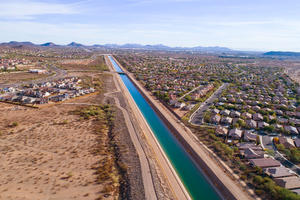 Pushed by necessity, the country’s least sustainable region evolved to master its water use. As climate heats up, other cities may adopt similar tactics.
Pushed by necessity, the country’s least sustainable region evolved to master its water use. As climate heats up, other cities may adopt similar tactics.
Conserving Water
Tucson has a strong water conservation ethos. It has to. The city is at the end of the Central Arizona Project, the last one in line to receive the precious water from the Colorado River. It also has a higher per capita of environmental nonprofits than other places in the United States and the presence of University of Arizona, which helps push conservation efforts. In order to increase vegetation and act on the data shown in the urban heat map, the Tucson Electric Company has a tree planting program and residents receive water rebates for passive water harvesting—a practice of letting water collect and soak into the ground, as well as installing gutters and cisterns to accumulate rainwater. A nonprofit organization named Watershed Management Group trains neighborhood volunteers in passive water harvesting that allows homeowners to make a “sponge” out of their land—a practice equally useful for flood zones and arid climates. Homeowners in the desert can collect water that falls on their property and use it for their needs. Rooftop water is funneled into rain barrels or diverted into the soil.
